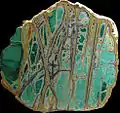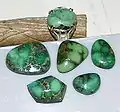Variscite
Variscite is a hydrated aluminium phosphate mineral (AlPO4·2H2O). It is a relatively rare phosphate mineral. It is sometimes confused with turquoise; however, variscite is usually greener in color. The green color results from the presence of small amounts of trivalent chromium (Cr3+
).[4]
| Variscite | |
|---|---|
 | |
| General | |
| Category | Phosphate minerals |
| Formula (repeating unit) | AlPO4·2H2O |
| Strunz classification | 8.CD.10 |
| Crystal system | Orthorhombic |
| Crystal class | Dipyramidal (mmm) H-M symbol: (2/m 2/m 2/m) |
| Space group | Pbca |
| Identification | |
| Color | Pale to emerald-green (pale green in transmitted light), green, blue green, yellow green, pale shades of brown or yellow, rarely red and colourless to white |
| Crystal habit | Encrustations and reniform masses |
| Cleavage | [010] perfect |
| Fracture | Conchoidal to splintery |
| Mohs scale hardness | 4.5 |
| Luster | Vitreous to waxy |
| Streak | White |
| Diaphaneity | Transparent to translucent |
| Specific gravity | 2.57 to 2.61 |
| Optical properties | Biaxial (-) |
| Refractive index | nα = 1.563 nβ = 1.588 nγ = 1.594 |
| Birefringence | δ = 0.031 |
| References | [1][2][3] |
Geology
Variscite is a secondary mineral formed by direct deposition from phosphate-bearing water that has reacted with aluminium-rich rocks in a near-surface environment.[5] It occurs as fine-grained masses in nodules, cavity fillings, and crusts. Variscite often contains white veins of the calcium aluminium phosphate mineral crandallite.
It was first described in 1837 and named for the locality of Variscia, the historical name of the Vogtland, in Germany. At one time, variscite was called Utahlite. At times, materials which may be turquoise or may be variscite have been marketed as "variquoise". Appreciation of the color ranges typically found in variscite have made it a popular gem in recent years.[6]
Variscite from Nevada typically contains black spiderwebbing in the matrix and is often confused with green turquoise. Most of the Nevada variscite recovered in recent decades has come from mines located in Lander County.[7]
Notable localities are Lucin, Snowville, and Fairfield in Utah, United States. Most recently found in Wyoming as well. It is also found in Germany, Australia, Poland, Spain[8] and Brazil.
Jewelry
Variscite is sometimes used as a semi-precious stone, and is popular for carvings and ornamental use due to its beautiful and intense green color, and is commonly used in silversmithing in place of turquoise. Variscite is more rare and less common than turquoise, but because it is not as commonly available as turquoise or as well known to the general public, raw variscite tends to be less expensive than turquoise.[6][4][9]
Gallery
 Cut slab of variscite at the Smithsonian. Specimen is roughly 0.5 m wide.
Cut slab of variscite at the Smithsonian. Specimen is roughly 0.5 m wide. Variscite filling the cracks in siltstone. The sample is from Queensland, Australia. The width of the view is 11 cm (4.3 in).
Variscite filling the cracks in siltstone. The sample is from Queensland, Australia. The width of the view is 11 cm (4.3 in). Polished variscite from Nevada.
Polished variscite from Nevada. Variscite and silver bolo tie. This variscite specimen contains inclusions of white crandallite and is from Clay Canyon near Fairfield, Utah
Variscite and silver bolo tie. This variscite specimen contains inclusions of white crandallite and is from Clay Canyon near Fairfield, Utah
See also
- Turquoise – Opaque, blue-to-green mineral: hydrous phosphate of copper and aluminium
- Variscan orogeny – Collision of tectonic plates resulting in the creation of mountains (same etymology, as named from the ancient locality of Variscia in Germany)
- List of minerals
References
| Wikimedia Commons has media related to Variscite. |
- http://rruff.geo.arizona.edu/doclib/hom/variscite.pdf Mineral Data Publishing – PDF
- http://www.mindat.org/min-4156.html Mindat
- http://webmineral.com/data/Variscite.shtml Webmineral data
- "Variscite Gemstone Information".
- Roncal-Herrero, T.; Rodríguez-Blanco, J. D.; Benning, L. G.; Oelkers, E. H. (2009). "Precipitation of Iron and Aluminum Phosphates Directly from Aqueous Solution as a Function of Temperature from 50 to 200 °C". Crystal Growth & Design. 9 (12): 5197–5205. doi:10.1021/cg900654m.
- Minerals of Nevada - Nevada Bureau of Mines Special Pub. 31 University of Nevada Press, 2004 Pages 78-81
- Gemstones of North America Volume III by John Sinkankas - Geoscience Press 1997
- "www.patrimonigava.cat". www.patrimonigava.cat.
- "Variscite Value, Price, and Jewelry Information - International Gem Society".